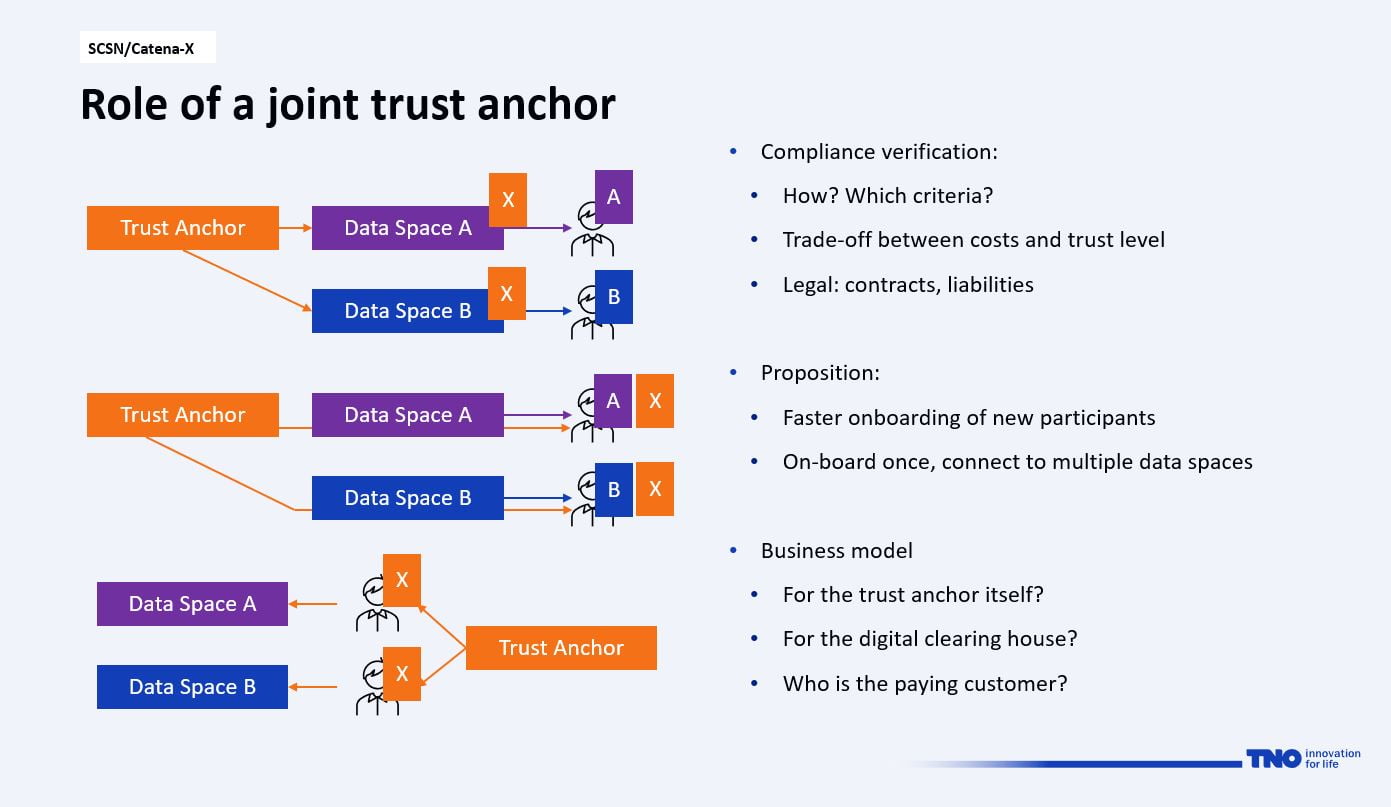In 2023, under the guidance of the CoE-DSC, two operational data spaces, SCSN and Catena-X, explored how end users of either data space could more easily use both data spaces without complex onboarding. What steps are needed to make this possible? What challenges are faced and what possible solutions emerge when going through these steps? We spoke to Matthijs Punter, Senior Researcher at TNO and involved in this exploration on behalf of the CoE-DSC.
Two operational data spaces: SCSN and Catena-X
There are still few data spaces in Europe, let alone in the Netherlands, that are operational and enable end users to share data or insights from data with each other.
The Smart Connected Supplier Network (SCSN), with hundreds of member companies, is perhaps the fastest growing data space. “SCSN focuses primarily on two categories of companies: manufacturing companies and service providers in the high-tech industry,” Matthijs explains. “Manufacturing companies have contracts with certified service providers. They supply the software so these companies can access SCSN.” This way, connected parties can exchange data more easily. Matthijs: “This involves sharing data throughout the entire supply chain. Think of data related to orders, invoices or technical product data to streamline the purchase-to-pay process, for example.”
In the Netherlands, SCSN is well on their way. In Germany, the same applies to Catena-X; a data space that focuses on the automotive industry. “Catena-X was created under the leadership of BMW and with the support of the German government. With this data space, they want to boost the digitalisation of the German automotive industry. With Catena-X, all parties involved in the production of a car can more easily share data with each other.”
SCSN and Catena-X aim to realise synergy between the automotive and high-tech industry
So why is the link between the two data spaces interesting? Matthijs sees that the automotive and high-tech industries are becoming increasingly similar and both data spaces can learn from each other. “Catena-X is very far along when it comes to traceability. In the automotive industry, it is important to have insight into exactly which parties were involved in the production of a car, which materials were used and to what extent materials such as metal are recyclable. That is also interesting for SCSN, because certain member companies investigate how to recycle metals. Conversely, Catena-X can learn a lot from SCSN. Of course, the car market is changing considerably when you think about the transition to electric driving. Although an electric car consists of fewer parts than a petrol car, the complexity of the parts does increase. For instance, when using chips or sensors. Both supply chains are now quite sensitive to disruptions. Whereas the automotive industry has traditionally focused on volume in general and volume of materials, it must now be able to anticipate the smallest changes in the production process. Think of a single order that needs to be shifted so that it arrives in time for the next link in the chain. SCSN is well equipped for that. Suppliers in the automotive industry therefore have started using SCSN more and more, despite the fact that automotive was not a key focus area of SCSN.”
Connecting data spaces to enlarge ecosystems
Reason enough for both data spaces to explore how connected parties from both data spaces can share data more easily. That is where the CoE-DSC came in, supporting both data spaces in their exploration.

Matthijs: “A network naturally gets more value when more parties are connected. We sat down during the Data Spaces Symposium and drew up a plan to answer two questions: (1) How can we facilitate the onboarding of a party that wants to participate in SCSN if it is already connected to Catena-X, or vice versa? And (2) Is it possible for parties connected to one data space to communicate and share data directly with parties from the other data space? The first step is relatively easy to achieve if the data spaces use the same standards for data spaces. Step two is a lot more complex because both data spaces need to be interoperable.” This complexity, according to Matthijs, is mainly related to business challenges because both data spaces are quite different when you look at their revenue models. Matthijs: “Catena-X has two money streams. First, it is an association with members who pay a membership fee to the association. Second, several operating companies that provide technical support for the data space, can get certified by Catena-X. End users and app providers have a contract with such an operating company to receive that support. SCSN, on the other hand, is a foundation without members and has a different financial construction. End users of SCSN have a subscription with service providers. Those service providers pay SCSN in proportion to the number of users. SCSN itself has an agreement with one operating company for the infrastructure. Thus, if you want to move towards a model that connects an organisation that participates in one data space to the other immediately, you will first have to solve this business issue by using the same business model or by making clear agreements on the financial handling.”
The role of a trust anchor to accelerate data spaces’ interoperability

Apart from harmonisation on a technical and business level, ‘trust’ is an issue that should not be underestimated. Because even if end users can share data within and between both data spaces and even if these data spaces have a good bilateral financial agreement, can end users trust that they are sharing that data with a trustworthy party? According to Matthijs, the role of a trust anchor is going to be decisive in organising trust, although in the coming years the market will have to make it clear what the role will look like and which party will fulfill it. Matthijs: “The trust anchor is a party that issues some sort of digital passport or certificate to an organisation to guarantee its reliability when it comes to sharing data. You can organise a trust anchor in three different ways.
- First, by issuing a guarantee of trust as a trust anchor to the data space itself. If data space A and data space B both have such a trust guarantee, then participants of both data spaces can also trust each other.
- A second possibility is that a trust anchor allows data spaces to pass on the trust to end users through a kind of digital badge. The combination of the membership of the data space and the trust guarantees that the party is trusted.
- The third possibility is that the trust anchor gives this digital passport or certificate directly to end users, without certifying the data space.
The market just hasn’t decided on those options yet. Again, the question is going to be who becomes the trust anchor’s customer: is it the data space or is it the end user? And which business model will be chosen?”
The Netherlands as a thought leader in the field of data spaces
For the CoE-DSC, the link between SCSN and Catena-X is considered a great use case to explore how data spaces can become interoperable. Matthijs: “In the future, companies will more often operate in multiple data spaces. How do you ensure that those data spaces can communicate with each other? Which standards and agreements overlap? We are proud that, with SCSN and through the CoE-DSC, we have enabled the exploration between SCSN and Catena-X to investigate this. This puts the Netherlands on the European map as thought leader with regards to the topic of data spaces.”
Would you like to learn more about this project in collaboration with Catena-X and SCSN? Or would you like to know more about the Dutch or European data spaces landscape? Please contact us at info@coe-dsc.nl.




